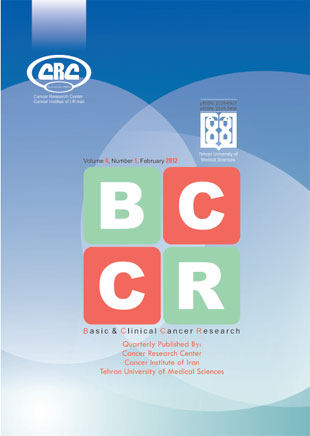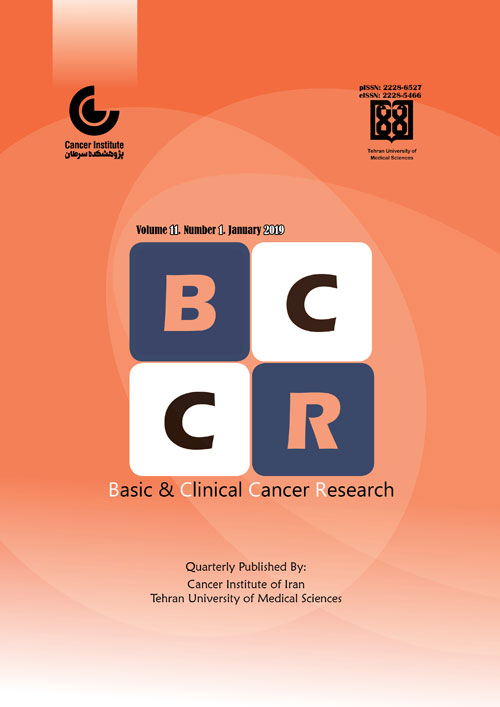فهرست مطالب

Basic and Clinical Cancer Research
Volume:4 Issue: 1, Winter-Spring 2012
- تاریخ انتشار: 1391/10/10
- تعداد عناوین: 5
-
-
Pages 1-6IntroductionCervical screening has decreased the incidence and mortality of cervical cancer worldwide. Due to a low incidence rate of cervical cancer in Iran and several Middle Eastern countries, an opportunistic screening is available for women in this region. We aimed to design and validate a questionnaire about Knowledge, Attitude, and practice (KAP) for cervical cancer and cervical screening among Iranian women.MethodsWe drafted a questionnaire about KAP of women about cervical cancer and its screening. Content validity was examined and the questionnaire was revised based on the scores provided by seven experts. We, studied reliability of the questions by performing test-retest analyses of data from 112 subjects and estimation of Cronbach Alpha and Interclass Correlation Coefficient (ICC).ResultsThe questionnaire consist 67 questions about cervical cancer and its screening including 30 characteristics, 20 knowledge, 9 attitude and 8 practice questions. Knowledge questions had higher validity (0.8) than attitude and practice questions (0.6). Cronbach Alpha for knowledge, attitude and practice were 80, 82, and 93 percent, respectively. Corresponding Interclass correlations were 88, 77 and 95 percent, respectively.ConclusionValidity and reliability of the designed questionnaire was sufficient to evaluate knowledge, attitude, and practice of women about cervical cancer and its screenin.
-
Pages 7-10IntroductionPigmented villonodular synovitis (PVS) is rare, benign and proliferative disorder of synovium which consists of villous and/ or nodular formations in joints. Diagnosis is determined by clinical features, aspiration of the joint, radiographic features and magnetic resonance imaging (MRI). The definitive treatment is the complete resection of affected tissue by open or arthroscopic synovectomy. Radiotherapy is recommended as an additive treatment in the control of recurrent or refractory disease.Case Presentationwe report a case of young woman with biopsy proven of PVS who after total synvectomy was referred for adjuvant radiotherapy.she received 36 Gy in 18 fractions and 12 month after treatment she has no sign of recurrence.DiscussionPVS is a rare benign disorder of synovium which is managed with surgical resection.Radiotherapy can be used as an additional treatment to increase local control.
-
Pages 11-15BackgroundHerbal medicine is a new complementary strategy for treating diseases such as cancer. However, its mechanism of action is not clear yet. This study investigates antitumor efficacy of Polygonum avicular extract on MCF-7 cell line.MethodsMCF-7 cells were treated with different concentrations of (50, 100, 150, 200, 250, 300,350 400 ng/µl) Polygonum avicular at different time intervals (6, 12, 24, and 48 hrs). In order to evaluate the expression level of FasL and Bcl2 genes, RT-PCR technique was employed.ResultsThe obtained results demonstrate that expression of FasL gene was increased in Polygonum avicular treated cells in comparison to control group. Down-regulation of Bcl2 expression was observed during the treatment.ConclusionPolygonum aviculare herbal extract may induce apoptosis through up-regulation of FasL and down-regulation of Bcl2 gene, however, its complete mechanism of action must be elucidated.
-
Pages 16-20Backgroundnow the vast majority of breast tumors are treated using Breast conservation therapy (BCT) method, including lumpectomy and radiotherapy. This study aimed to evaluate the effects of intraoperative frozen section in patients undergoing breast conservation surgery.MethodsTotally 237 women who included in the category for breast conservative or oncoplastic surgery and post-operative radiotherapy (Early breast cancer Stage I,II and Stage IIIA after neoadjuvant chemotherapy and down staging) were enrolled in this prospective study from March 2009 to June 2011.ResultsIn frozen section, totally 88 margins (6.1%) in 60 patients (25%) was positive (1-5 positive margins/ patients) that all of these patients were re-excised. In precise pathologic view the margins in 7 patients (2.9%) was positive that comprised 4% of all margins, furthermore the results showed closed margin in 4 patients. false negative in our study occurred in 0.8% of patients and in 0.1% of margins (sensitivity 100% and specifity 99.2%).Conclusionwe designated intraoperative margin assessment by frozen section as an effective method in decreasing the rate of additional operations for margin control. Additionally, adequate margin width is accessible during same operation.
-
Pages 21-29BackgroundPatients with breast cancer are predisposed to some psychiatric symptoms and mental disorders due to their life styles or disease conditions. These problems cause patients to deal with daily stress, feeling guilty, anxiety, dysphoric mood and impaired social relations. Such problems will lead to serious mental disorders. Therefore, life skills training may help the patients to cope better with them and improve their mental health.MethodIn an experimental study, 50 breast cancer patients were selected randomly and assigned to 2 experimental and control groups. The experimental group attended life skills training classes for 10 weeks continuously (The duration of each class was 2 hours). Participants in both experimental and control groups completed a GHQ-28 questionnaire form before the commencement of classes and after 2 weeks to 2 month of the course completion, the form was completed again. Statistical method used in this study was T-test.ResultsIn life skills training group, depressive and anxiety symptoms,  somatization  disorders, sleep disorders and disorders of social functioning significantly decreased (p<0.0001). This change was not observed in the control group.ConclusionThe results showed that life skills training is an effective method in reducing symptoms of depression, anxiety, sleep and somatic disorders. Also, it will be useful in reducing problems of social dysfunction.


